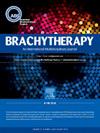Quality of life of patients submitted to radical radiochemotherapy for cervical cancer: Comparison of outcomes between 2D and 3D image guided brachytherapy
IF 1.8
4区 医学
Q4 ONCOLOGY
引用次数: 0
Abstract
PURPOSE
To assess QoL in patients with locally advanced cervical cancer treated with radical radiochemotherapy combined with either 2D or 3D brachytherapy, and to compare outcomes between both techniques.
MATERIALS AND METHODS
A cross-sectional analytical study was conducted from January 2019 to March 2020. EORTC QLQ-C30 and QLQ-CX24 questionnaires were applied at five time points: before treatment, and 1, 3, 6 and 12 months after treatment. Descriptive statistics, Pearson's chi-square, Fisher’s exact test and Bonferroni test were used (p ≤ 0.05).
RESULTS
Seventy six out of 82 patients completed all the assessments. The overall mean global health status significantly improved from 63.7 to 72.0 (p = 0.019), with no significant difference between the 2D and 3D brachytherapy groups (69.8 vs. 67.8; p = 0.672). All functional domains of the QLQ-C30 improved over time, including financial difficulties, regardless of the brachytherapy technique. Sexual activity increased significantly (2.5–32.4, p < 0.0001), but also did sexual worry, menopausal symptoms, reduced sexual enjoyment, and vaginal dysfunction.
CONCLUSIONS
Overall improvement in global health and functioning were observed in patients with locally advanced cervical cancer, regardless of the brachytherapy technique used. Despite improved sexual activity, aspects of sexual dysfunction increased, highlighting the need for comprehensive, multidisciplinary care that includes sexual and psychological support, emphasizing the need for individualized care.
宫颈癌根治性放化疗患者的生活质量:二维与三维影像引导下近距离放疗效果的比较
目的:评价局部晚期宫颈癌根治性放化疗联合2D或3D近距离放疗患者的生活质量,并比较两种方法的疗效。材料和方法:2019年1月至2020年3月进行横断面分析研究。在治疗前、治疗后1、3、6、12个月五个时间点应用EORTC QLQ-C30和QLQ-CX24问卷。采用描述性统计、Pearson’s卡方检验、Fisher’s精确检验和Bonferroni检验(p≤0.05)。结果:82例患者中有76例完成了全部评估。总体平均全球健康状况从63.7显著改善到72.0 (p = 0.019),2D和3D近距离放疗组之间无显著差异(69.8 vs 67.8; = 0.672页)。无论采用何种近距离治疗技术,QLQ-C30的所有功能领域都随着时间的推移而改善,包括经济困难。性活动显著增加(2.5-32.4,p < 0.0001),但性焦虑、更年期症状、性享受减少和阴道功能障碍也显著增加。结论:无论使用何种近距离放疗技术,局部晚期宫颈癌患者的整体健康和功能都得到了改善。尽管性活动有所改善,但性功能障碍的各个方面也有所增加,这突出了对包括性和心理支持在内的综合多学科护理的需要,强调了个性化护理的需要。
本文章由计算机程序翻译,如有差异,请以英文原文为准。
求助全文
约1分钟内获得全文
求助全文
来源期刊

Brachytherapy
医学-核医学
CiteScore
3.40
自引率
21.10%
发文量
119
审稿时长
9.1 weeks
期刊介绍:
Brachytherapy is an international and multidisciplinary journal that publishes original peer-reviewed articles and selected reviews on the techniques and clinical applications of interstitial and intracavitary radiation in the management of cancers. Laboratory and experimental research relevant to clinical practice is also included. Related disciplines include medical physics, medical oncology, and radiation oncology and radiology. Brachytherapy publishes technical advances, original articles, reviews, and point/counterpoint on controversial issues. Original articles that address any aspect of brachytherapy are invited. Letters to the Editor-in-Chief are encouraged.
 求助内容:
求助内容: 应助结果提醒方式:
应助结果提醒方式:


